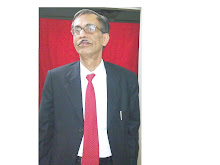In today's Anandabazar Patrika (April 10), Anirban Chattopadhyay penned an article on 'Ashmita And Hinghsa'. He was inspired by Nobel luarette Amartya Sen's 2006 book on ' Identity and Violence' which I have not been fortunate to read. Anirban makes two points. One, he was a fool in retrospect in raising a hopie that the CPM-cultivated 34-year old communist identity-iduced violence (or, violence-iducedidentity?) would be replaced by something new ethos, new politics of non-violent identity of the Bengal citizenry, oncethe CPM had lost power to Mamata Banerjee's Trinamool which secured 185 seats out of a total of 294 seats in WestBengal, with the CPM-led front of 14 political parties got only 61 seats. Second, he lament that the last one year, Mamata missed a great opportunity for effecting the long-desired transformation from identity-induced violence to non-violent plurality of identities, given the Mamata-centred Trinamool Party in power.
Journalists are known for their impatience and their art of breaking new grounds every hour/ every other day. It is not surprising that it took nearly a year to recognise that Anirban hoped for the impossible in foolish day dream. His thesis is that the CPM had cultivated for long to divide the people into 'We, thecommunists' and'they, the rest who do not support us/ criticise us'. As more and more of the citizens became part of 'We', the more the 'We' became intolerant of the 'they' and the process of increasing thesize of 'We' necessitated perpetuation of increasing violemce, with merging of Alimuddin Street (CPM's West Bengali head qrs.) and the Writers' Building (StateGovernment hqrs). He had hoped with CPM out of powe, this link is gone and hence thedesired transformation should be automatic. This kind of logic is onnly possible in tthe most popular vernacular daily in Bengal: because this provides pesudo-intellectaul entertainment: a round-about way of finding fault with Mamata Banerjee, something that at lead 2 out of 4.5 voters in the statewould like to read and enjoy.
Yes, it is even foolisg to feign one's foolishness. With CPM out of power, the identity-induced violence would vanish in thin air, as if CPM willlike to lose its identity and the strength of its power of violence? Where inhistory has this happened? Second, Gandhi as an opposition to State power had opted for non-violence; we are yet to know of Gandhis in State power adopting non-vilence as a weapon against violence, at least not after Emperor Ashoka when he had concentrated on spreading the message of Budhha. So, why did journalist Anirban expect CPM to shirk violence: just because it lost power? Why did he expect Trinamool not to engage in violence as a weapon to counter CPM's violence? This is clearly mischievious expectation with retropestive effect. Yes, Mamata had in the past said that she was favour of change and not in taking revenge for the past. It does not mean that CPM has agreed to follow suit? Why should then identity-induced violence cultivated for so long vanish suddenly in thin air?
A change of power is of course an opportunity to come to truce and shun identity-induced violence. Who has the responsibility to take this opportunity? Only Mamata because she is the new chief minister? What about the leadership of the Congress, the CPM and other parties - they have no responsibility to take this opportunity? Was it not an opportunity for the journalists to pave the way for public opinion on favour of shunning violence by all parties. The press has only been reporting such violence and blaming one or the other party.
The problem of violence - at least in the sense of using muscle power and arms for aborodh, dharmoghot, for winning identityelections and scaring away the common people, has nothing to do with dominance of one single identity of an individual / group over other many identities of the same individual/ group. Violence is a natural method deployed by human beings to win freedom from others' oppression or win power to subject others to oppression. But when the likelihood of winning through violence declines, people would be less inclined to adopt violent methods. How do we get WestBengal to reach a stagewhere violence does not become commercially attractive? That is a separate issue. Of course not an issue meant for journalists and columnists to deal with.
Wednesday, April 11, 2012
Subscribe to:
Post Comments (Atom)

No comments:
Post a Comment